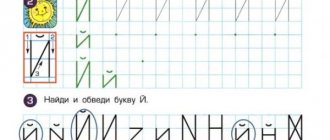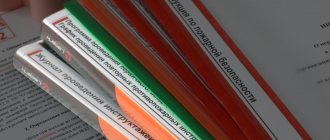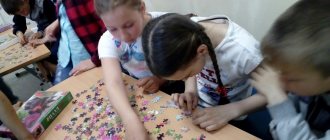Thematic music lesson at a preschool educational institution. Senior group
Summary of a music lesson for children 5-7 years old. We sing, knock, play - we strengthen our health!
Direction: development of musicality, preservation of physical and psychological health.
Educational field: music. Integration of educational areas: music, communication, socialization, health, cognition, physical education. Goal: comprehensive development of cognitive processes and musical abilities of children of senior preschool age through the use of pedagogical health-saving and infrared technologies. Objectives: educational: -improve vocal skills and pitch hearing in the process of singing activity; — improve timbre hearing, strengthen children’s ability to distinguish and determine the sound of musical instruments; - encourage children to be active in musical and speech activities; — enrich children’s speech by including in the vocabulary words that define the nature of music. developing: - develop a sense of rhythm, auditory attention, - promote the development of memory, logical thinking, imagination; — improve speech motor skills; — develop children’s creative activity and communication skills. educating: - to cultivate a culture of listening, a love of music, a desire to engage in musical activities; — cultivate a culture of communication and a sense of empathy; - encourage children to perform motor improvisations; — to develop children’s emotional responsiveness to feelings and moods expressed in music. health-saving: - creating a positive psychological atmosphere in class, reducing emotional stress; — increasing children’s self-esteem, their confidence in their own strengths and performance results (individual and collective); — formation of motivation for creative self-expression in the process of collective activity; — learning the basics of proper singing breathing, expanding lung capacity; - reduction of visual tension; — formation of a conscious attitude of children towards their health and development of their own health improvement skills; - reducing muscle tension by teaching the basics of play self-massage. Planned result: - establishment of a friendly relationship (teacher - children); — creating and maintaining a positive emotional background throughout the lesson; — learning a new song and then performing it; - formation of stable habits for a healthy lifestyle in children; — mastering the skills of self-massage and self-regulation. Progress of the lesson: Children enter the hall where they are met by the music director. Musical director: - What kind of guests are rushing into the hall? I'm glad to see you guys! Let's gather in a friendly circle: (everyone gathers in a circle) On the right is a friend, and on the left is a friend! Hello my friends! Today I want to ask you this. When you come to kindergarten, what do you say to those you meet? (children's answers) That's right, all well-mannered people, when they meet, wish each other health - they say... “Hello.” And today I invite you to greet each other in an unusual, musical way. Our musical greeting is a song - an echo. Where can you find an echo? (children's answers) What does the echo do? (children's answers) That's right, it repeats everything. Now you will become my echo. I will sing a musical phrase, and you will repeat it like an echo. And when I raise our clasped hands up, we will all loudly shout “Hurray!” Is the task clear? 1. Musical greeting “How great!” (author of words by E. Plakhova) (unaccompanied): MR: - It’s great that we all gathered here, gathered! Children: - It’s great that we all gathered here, gathered! MR: - Smile at your friends, Smile, smile! Children: - Smile at your friends, Smile, smile! MR: — All friends gathered together! Children: - All friends gathered together! All: - Hurray! Musical director: - Well done! So we greeted each other and everyone present in the hall! And now... 2. Self-massage “Voice, wake up!” (author E. Plakhova) Let's clap a little... (clap hands) And rub our palms... (rub our hands together) And now even harder, To make it hot! (rubbing your palms more quickly and intensely) From bottom to top... from top to bottom... (stroking movements with fingertips on the neck) Our little voice, wake up! (clap their hands) From top to bottom... from bottom to top... (stroking movements with fingertips on the neck) Success awaits us in singing! (clap their hands) Guys, what holiday will we celebrate soon? That's right, New Year is coming soon. And on New Year's Day it is customary to give gifts. My friends, do you like gifts? (answers) I also have a gift for you today, but not a simple one, but a musical one... Sit down near the piano... (children sit down) My gift is a new song... Sit down comfortably... 3. Express learning of the song “Sleigh” (music by A. Filippenko, lyrics by T. Volgina) using mnemonics. (learning takes place sitting on chairs, and the final performance standing MR reminds children of the singing position, of posture) Musical director: - You sang the song perfectly! Our efforts were not in vain! And while you were all working, were your eyes tired? No problem! We will help them! Let's give them a massage too! Get in order! Let's do some exercise for your eyes! 4. Visual gymnastics “Christmas tree”: Here is a big tree, this height. (Perform eye movements from bottom to top) It has large branches. This is the width. (Moves the eyes from left to right) At the top there are big bumps, (Eyes up) And at the bottom there is a bear’s den. (Eyes down) The clubfoot sleeps there during the winter And sucks his paw in the den. (Close their eyes) Musical director: - Well, our eyes have rested. Guys, did you like how we sang the wonderful song “Sleigh”? (children's answers). We all sang together, so what did we sing? (in chorus) Guys, do you think it’s possible to sing music... with your hands? (children's answer) Let's try? Look what I have prepared for you: for girls - these wonderful flowers that are put on your hand like this... And for you, boys - these moths. Please take a seat in our hand choir. Girls, please sit down on the chairs, and boys, like real gentlemen, stand behind them. Girls put flowers on their hands, and boys put butterflies on their hands. It's been winter for a long time now - Snow covered the fields and houses. And we will play music and remember summer! In the first part, flowers bloom, And in the second, moths flutter! Flowers will bloom, moths will circle... And in the end they will become friends with each other! (E. Plakhova) 5. Innovative music-pedagogical technology “Chorus of Hands” according to the method of T. Borovik (motor two-voice) Children in movement convey the form and musical phrasing of a musical work. Musical director: Get ready, kids! There will be a new game! We will play with you - create live rhythms! You have in your hands large flowers and small moths, from which you and I will create rhythmic formulas and clap them. The big flower for girls is a long note “TA”, and the small butterfly for boys is a short note “Ti”. Now try to line up like this (display the rhythm formula on the screen). 6. Game “Living Rhythms” Children build a rhythmic formula, and the rest pronounce and clap the rhythm. Then the rhythm formulas on the screen change twice more, and other children participate in their construction. The ticking of a clock is heard. Musical director: - My friends, listen... don’t you hear anything? (children's answers) Time flies, now he orders me to rest. The clock whispers like this: TICK-TOCK, TICK-TOCK! Take the plates, my friend! Don't stand still! Repeat everything after me! 7. Musical and rhythmic game with plates “Clock” Everyone gathers in a circle.
Musical director: — Guys, what’s your mood now? (answer) Let's smile at each other again! Did you like our meeting? What did you like most? (children's answers) Believe me, I have never met such smart, musical and attentive guys anywhere! I say thank you! I was very pleased to meet you today, but our watch tells me that the time for our meeting is coming to an end. I would really like you to decorate this Christmas tree now. If you are in a bad mood right now, attach a white ball to the Christmas tree. If you are in a great mood, attach a red balloon. (children decorate the Christmas tree) I wish you all the best, my friends! In memory of our meeting, I give you this most wonderful, funny watch. Let them count down only pleasant and happy moments for you in the New Year! Goodbye! The children leave the hall.
We recommend watching:
Notes on educational activities for the senior group on the topic: Autumn Notes on educational activities in the senior group “Journey to the magical world of musical instruments” Notes on educational activities in the senior group “On a visit to Domisolka” Notes on musical educational activities for children in the older group
Similar articles:
Summary of thematic music lesson in the senior group
Summary of the direct educational activity “Music” in the preparatory group
Scenario for a musical festival for preschoolers
Conversation in the senior group of kindergarten on the topic: How people use leather and wood
Lesson notes for the senior group of kindergarten
Techniques for learning a song in a music lesson
The choice of song to learn in a music lesson is not arbitrary. A school song must meet certain requirements determined by the level of vocal training of students. Songs for younger schoolchildren are especially carefully selected.
Their form should be extremely concise, limited to one period. The melody is emphatically expressive, bright, melodious, with a clearly drawn melodic pattern. The rhythm is simple, alternating no more than three types of durations. In this case, the vocal performance should be natural and clear, the tone should be diatonic, the range should be no more than an octave. These criteria are usually met by folk songs, the high artistry of which is undeniable. The melodies of folk songs are well perceived and absorbed by children.
It would not be amiss to say here that if the students liked the song, then difficulties in learning it are easier to overcome. Children react very sensitively to the melody and lyrics of a song, to its melody, expressiveness, and general emotional mood.
Increasing the complexity of the vocal repertoire is permissible only after students learn to easily cope with the tasks set at the initial stage: purity of intonation, correct tempo rhythm, sense of dynamics, etc. But even after complicating the repertoire for learning, one must remember the basic requirements for school songs. They should captivate children with their melody and lyrics.
So, work on the song began. The process of learning a song is quite complex; it consists of repeated repetitions of phrases, verses, and choruses with students. At the same time, time is limited to academic hours and other thematic planning points. In such conditions, the method of working on a song using educational role-playing games and musical tasks based on the material of the song being learned is very productive. In this case, the most important tasks are the correct pitch intonation of the melody, clarity of rhythm, freedom of breathing, ease of sound formation, expressiveness of dynamics and correct articulation.
More to see Profession - music teacher
Simple one-voice choruses of folk songs are usually learned in their entirety, without breaking them up into phrases.
The teacher performs the chant or phrase of the song 2–3 times. The same material is then played on the instrument at a slow tempo. After this, the children are invited to sing the fragment they heard on their own.
The first sound is the most difficult for children, so it is necessary to help students sing it with an instrument or voice with intonation correctness and pitch accuracy. There is no need to rely on children’s ear for music and memory; in most of them they are poorly developed and unstable. Therefore, it is always necessary to give students a point of support, the right mood, by singing or playing on an instrument the fragments of the song they are learning together with the children.
Do not forget that vocal tasks must constantly change during repeated repetitions of phrases, fragments, and verses. This switching of attention from task to task instead of tedious and not always pleasant mechanical repetitions will make the process of unlearning an exciting game.
Each task proposed by the teacher must be justified, based on deep preliminary analytical work on the work. The teacher must immediately analyze the children’s singing, snatch distortions and shortcomings from the sounding material, and the next task is to correct or completely eliminate them. This means that in the vocal and technical arsenal of a music teacher there must be all sorts of techniques, methods, so-called “tricks” to eliminate the shortcomings of the individual and group sound of a song.
It is best to consolidate the material learned by schoolchildren (phrases, verses, choruses) in small groups of 5-6 people, giving others the opportunity to listen and evaluate the singing of their classmates. Then the composition of the groups is changed in such a way that all students in the class go through the task of consolidating the learned material. Children who sing poorly should be given the opportunity to sing the consolidation task several times, including them in different singing groups.
Also see Notes on school music education
When learning a song, you can and even should practice using musical notation. In my lessons, I give children the opportunity to follow the musical text while singing using the Finale computer program. This multifunctional music editor allows you to use a cursor moving over the notes to create an extraordinary educational effect, built according to the scheme: “hear - see - sing - remember”.
Song "My Teacher"





